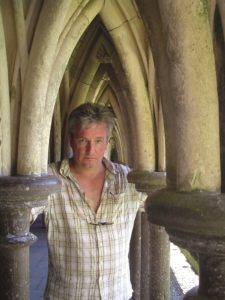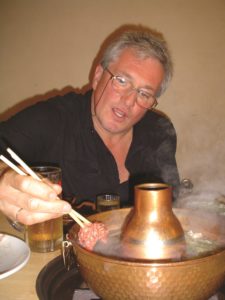By Cara Tasher, choral conductor and teacher
Cara Tasher: What was it like growing up in Lithuania?
Vytautas Miskinis: As I child, I lived in the beautiful village of Zervynos where half of its inhabitants were relatives on my mother’s side. It was quite ordinary except for the responsibilities I held at such a young age. There I completed my first primary school class and then began in my second year in the capital city of Vilnius. As far as I remember I have always loved singing, no matter where and when; during meals, in the forest, the bathroom . . . Very soon my parents noticed my interest and enrolled me in the boy’s choir where my music education officially began. I succeeded easily in the classes and this attracted the conductor’s attention. It was he, Mr. H. Perelstein who directed and guided me along this road and from whom I gained all of my musical knowledge. I feel proud of taking private music lessons as the great W.A. Mozart, J. S. Bach, A. Bruckner and E. Elgar also studied privately. In fact, I learned and achieved most in music while under the direction of Perelstein whose personality had great influence on me. At 17, I entered the Music Academy and became assistant conductor, and at the age of 21 became the second conductor of the Kaunas State Choir. Later, at 25 years old, I served as Artistic Director of the boys’ choir after my predecessor Perelstein had left Lithuania for the USA. Soon after, I founded the Azuoliukas Music School. Everything described above seems a simple biography, yet the insular environment in which we lived was actually quite complex: we were forbidden by the government to perform abroad and the spread of musical information was very limited. There were politicized music textbooks and the study of a foreign language was one of the only means to learn about music literature of other cultures.
Criticism aside, musical education and professional music training was of high priority to the government. The pyramid of professional learning functioned well: music school, college of music (equivalent to the current Conservatory), Higher School of Music (now the Academy of Music). Then, a graduate of the Academy of Music was guaranteed the right to a job, whereas now it is a personal and private matter of fortune. Also during that time, children’s summer holidays were a matter for state consideration and working parents could afford to send their child to the well-established pioneer camps where childcare, food, lodging, sports and entertainment were all provided, ensuring that children would have a pleasant holiday. Unfortunately with current costs for education, summer camps are too expensive for many families and are often considered a luxury. With the disappearance of the state-camp network, I take pride in organizing summer camps for 130 choirboys annually, yet the duration of camps has already become shorter and less affordable for many families. Still, don’t take my words as nostalgia for the old times. We live in a “modern” society where wealth depends on economic profitability. To close, I wish to quote an ancient Roman saying: “If you are not educated in music, you are plebeian”. Music in many ways has become the object of hedonistic needs rather than part of aesthetic education. How sad! Today music education is less well supported and participation in school choral activities is no longer compulsory. The law mandates that the Ministry of Education and Science regulates curriculum and schools are financed and maintained, but the municipalities control their functions. Such are the changes in the era of capitalism.
CT: Discuss the transformation of your approach to making music after 1990, if any. Did choral music and music education change?
VM: In the past, no expense was spared for choral music education to prove the superiority of the Soviet education system over western standards, as it was one of the areas where a political approach could be applied. It was easier to manage the masses than a single person. Therefore, mass participation in choirs and music education was greatly encouraged, and there was even an official position of Coordinator of the Development of Art and Mass Culture. As you may know, in addition to professional art, much attention was paid to amateur art maintenance and development. Under the Soviet rule, a wide network of children’s music schools was developed and fully maintained by public funds. Commonly, businesses and factories encouraged and funded employees’ participation in choirs, dance groups, folk bands or orchestras, and some workplaces built their own cultural centers. Involvement in music and music education was considered mandatory.
Fortunately, despite the Soviet regime, many positive things emerged. For example, music education was provided from pre-school to secondary education and it was obligatory for schools to have a choir, band, orchestra or dance group. Unfortunately, after the restoration of independence to Lithuania, the network of music education was ruined, and not only due to the lack of funds for maintenance of all cultural educational institutions, but also in order to erase and destroy any memory of the Soviet regime. Sadly enough, even now concepts such as the ‘Soviet system of education’, ‘Soviet heritage’ or ‘Soviet network’ are partially associated with art, largely because the amateur art network was fully sponsored by the former Trade Unions. Unfortunately, with the restoration of independence, these were destroyed for political reasons.
After Lithuania became a member of the European Union, surprisingly, partial support for highly developed and well-functioning structures is now being revived. It seems controversial when European standards are considered to fit and match our national educational system, not to mention our individual cultural and national development. Unfortunately, today’s ‘modernized’ models of life are integrated according to the commonly patterned standards of the EU.
Still, the main cultural identity puzzle seems to be how to protect and maintain the traditional things that have justified themselves throughout time.
CT: How have the traditions of Lithuanian choral music been kept alive?
VM: Frankly speaking, open opposition to Soviet rule has never been demonstrated since it was dangerous or simply impossible. The national Song and Dance Festival provided an opportunity to preserve a tradition of our national cultural heritage. As for the festival’s repertoire, no one dared to argue about its content. In general, anything that didn’t oppose the ideology of the Soviet system was accepted. Folk song and dance were paid special attention as they supported our national identity. However, the repertoire had to be internationally varied, usually consisting of Lithuanian, Russian, Latvian, Estonian or other international music performed in their national languages, and then translated into Russian and Lithuanian.
As Lithuania was a bilingual country, the Lithuanian and Russian languages were obligatory, but the Lithuanian language was always a priority for native Lithuanians; it was taught at school, used in public and considered to be the mother tongue in all senses. The Soviets feared and neglected to accept modernism as it was associated with Western influence, which for Soviets meant capitalism – a great evil that objected to the principles of communist society and ideas.
Despite any communist attempts to limit or ignore the influence of the West, it spread rapidly in the form of a tangible declaration of a “hidden” thought demonstrated mainly through instrumental music. With an increased quantity of symphonic music composed, loud unspoken messages or ideas were sensed hidden deeply within the music. At the same time, the communist ideas and the praise of the regime under the established rules and regulations were openly stated and encouraged. Lithuanian folk art was neither objected to nor resisted, on the contrary, it was tolerated and even developed. Meanwhile, intellectuals found certain elements of national resistance in the ethno-cultural heritage and easily noticed these since the word is a powerful tool to carry a clear message; song texts possessed ambiguity or elements of Aesopian language. For example, in the folksong harmonized by M.K. Čiurlionis Oh, flying, flying the text states: “Oh, the swans fly, fly to defend the motherland and call the brothers for….” But, the censors of the Lithuanian folk songs found nothing specific in the text to criticize as the songs more generally alluded to ideas hidden between the lines or within ambiguities. And if a composer pleased the regime by composing at least one song in praise of the Soviet system, he could make music more freely, as censors favored composers who demonstrated loyalty to the government, and consequently scrutinized their works less harshly.
CT: Your elegance and fluidity within different styles is notable. What’s the piece you’ve written that you are most pleased with?
VM: I have written a great number of songs of different genres and various styles and roughly 800 choral works and I am particularly proud of my works for children and sacred music compositions. I am especially pleased with my Light Mass for two pianos and jazz trio that I recently set for orchestra. Then comes my musical tale for children The Tale about Tenderness whose text is based on American author Steiner’s book. Currently I am setting St. John’s Passion in German for the Cathedral of Graz, Austria, for Evangelist (tenor), Petrus (tenor), Jesus (bass), Servant (soprano) and a cappella SATB choir (35 minutes). I have also written an hour-long version in Latin with organ and orchestra. Among European conductors I have been given the nickname “Mister Cantate Domino” for a simple reason: Cantate Domino is my most frequently performed work and the publisher Carus Verlag considers it to be a bestseller. I would never wish to compose a piece that would discredit me as a composer and so I am extremely cautious in publishing my works, in case my work turns out to be of no interest for the public: I would not dare to disappoint a listener by any new work of mine.
CT: Your compositional output is very abundant for a contemporary composer. Please talk about your compositional process and what inspires you.
VM: What always inspires me is the poetry. I always read a lot of poetic texts, especially children’s poetry. Sometimes the text “ignites” me spontaneously, whereas sometimes I feel indifferent to it. It is more difficult with commissions, especially when the text is given and the direction of the style is described. Luckily, I am pretty quick at composing, because every minute I live with music in my head, thoughts, and sometimes in my dreams that I try to write down before the audiovisual has evaporated. I tend to exploit every free minute I possess; otherwise I wouldn’t manage to do much. I write while waiting for a flight, aboard a plane, during any spare minute at the Academy of Music, when a student doesn’t appear for his conducting lesson, at home, at work, simply everywhere. Unexpectedly, in the year 2012 I received ten choral commissions. I create many without specific focus and direction, which is useful in expressing my personal self through music. Sometimes the ideas are born while I’m driving a car. Then I stop and hurry to capture the thoughts on any piece of paper and rush home to express them in musical form. For example, Cantate Domino and several other compositions were composed like this. Also, I love nature. It recharges me and clears the mind from any negative thoughts that surround us in our lives. When I feel sad, I am likely to compose joyful music. When I am optimistic, nostalgic or melancholic music comes to my mind. Who knows, maybe this happens due to the balance in wild nature as well as in the nature of man. After the rain, you wait for the sun to shine and as you long for it, moments of joy follow the sadness and euphoria calms within time passed.
CT: Through the many Lithuanian choral festivals, you have access to your country’s most talented musicians. Has the rich choral tradition of Lithuania helped the country to gain recognition worldwide?
VM: Lithuania is truly rich in talents. Our ethno-cultural heritage is very rich and plentiful. Within our population of three million, there are a significant number of choirs and professional artists in many fields. The choral movement is one of the most powerful. The power of singing helped Lithuanians to withstand the twenty years’ pressure from the Soviet Army, and to long for the Independence of Lithuania. It is no wonder that the phenomenon when a song turned out to be mightier than a weapon was called The Singing Revolution. We’ll never forget the tradition of the giant Baltic Song Festivals that, in 2006, UNESCO proudly singled out as a cultural practice considered a “masterpiece of humanity.” I was honored to be part of the creation of a law passed in 2008 to support the continuity of the Lithuanian Song Festival tradition. The fact that three Lithuanian choirs are European Grand Prix winners speaks louder than words. Well, we admit we also have problems, but if we compare our situation with the many countries where choral singing is less cultivated, I dare say that our situation is good enough so far. I feel justified in making comparisons since the World Choir Council contemplates these problems on the global scale, where I have the honor to represent Lithuania.
We have a lot of interesting artists of all genres: pop, jazz, and classical music. We also have many interesting composers. But how could we make their names known to the world? The problem is that having lived for fifty years behind the ‘iron curtain’ we were anonymous to the major part of the world. And how should we find a foreign publisher who would believe in the talent of a composer and wish to promote Lithuanian music to foreigners?
I feel very disappointed in the current situation, yet I am a happy exception: the best choirs in the world perform my works, and ask me to work for them. It is a great honor and happiness, and at the same time, it is a great responsibility to represent Lithuanian art.
CT: Finally, you were awarded the Enlightened Person of Lithuania in 2006. Describe the path to enlightenment and tell us more.
VM: This high award was given to me for my work with boys. I am the artistic director of the largest boys’ and youth choir in all of Europe, a system consisting of 450 singers. I like to joke by calling my singing team the “all men’s sexy choir!” The system includes eight ensembles of different ages and ten assistant conductors. It is an integral system including an eight-year curriculum, where they learn solfeggio, music history, and conducting, and study voice privately as well as a musical instrument of their choice. Choral singing is the main lesson. The award granted is the greatest evaluation of my ability to promote interest in music in such a large number of boys who devote their time to musical education. In 2002 I was nominated “Best author of the year and composer of frequently performed music abroad” and over the last decade, three of my works have been rated as the most frequently performed by choirs in Europe. The fact that I am interesting to someone makes me happy.
CT: Thank you for allowing us to feature you as well as a very special thanks to our colleague and friend Darius Polikaitis, the artistic director of Dainava Lithuanian Chorale in Chicago, for translation of the work provided here, as well as this helpful pronunciation guide.
VM: My sincere thanks to ICB for the opportunity to share my thoughts. Of course, I receive a lot of e-mails with a variety of questions, and in most cases inquiring where to find my music. Information about my works can be found on the website www.mic.lt in the composers’ section. The information only pertains to my works printed by foreign publishing houses: Carus Verlag, Editions Ferrimontana, Schott Verlag, Germany; A Coeur Joie, France; CMEdiciones Musicales, Spain; Astrum, Slovenia; Musica Baltica, Latvia; earthsongs, Laurendale Associates, Santa Barbara, USA. Information about the Ąžuoliukas choir can be found at www.azuoliukas.lt and my personal email is: v.miskinis@azuoliukas.lt.
|
Mano gimtinė Ten, kur Nemunas banguoja Tarp kalnų, laukų Broliai vargdieniai dejuoja Nuo senų laikų. Ten močiutė užlingavo Raudomis mane, Į krūtinę skausmą savo Liejo nežinia. Girios ūžė ten, minėjo Praeities laikus, Kai lietuvis netikėjo, Jog belaisviu bus. Ten apleistos pilys griūva Ant kalnų aukštai; Milžinų ten kaulai pūva, Verkia jų kapai. Ten užaugau, iškentėjau Aš kančias visas Ir pamėgau, pamylėjau Vargdienių dūmas. O tos dūmos vargdieninės Griaužia kai kada, Tartum rūdys geležinės Amžina žaizda. |
|
There is my birth place Where the river Nemunas flows through the hills and plains, there our poor brothers lament their fate, as they have for ages past. There my mother rocked me to sleep with mournful lullabies, pouring her heartache into my bosom. There the forests moaned remembering the times of the past, when nary a countryman could have believed that he would be a slave. There abandoned fortresses lay in ruins On the hilltops high; they mark the resting places of giants, their weeping graves. There I grew up and lived through many hard times, and grew to love the common life. But ever so often, the memories of that life gnaw at me, As rust eats away at iron, As a permanent wound. |
Maironis (born Jonas Mačiulis, 1862–1932) is one of the most famous Lithuanian romantic poets. He is known as the “great poet of Lithuania’s rebirth”. Maironis, a Roman Catholic priest, lived most of his life under the Russian Czarist occupation. His patriotic poetry was at the forefront of a Lithuanian national revival that ultimately led to independence in 1918. The text of this piece is typical of Maironis’s creative oeuvre. In attempting to awaken his countrymen to their national identity, Maironis speaks lyrically of Lithuania’s beauty, of its glorious past, of its sufferings and struggles. Yet he identifies with and addresses the common man (rather than the aristocracy), for it is there that he sees hope for the future of Lithuania as a free nation.
Vowels:
a = [ʌ] (up) or [a] (far)
ą = [a] (far)
e = [ɛ] (met) or [æ] (cat)
ę = [æ] (cat)
ė = [e] (cafe)
i = [I] (sit)
į = [i] (sleep)
y = [i] (sleep)
o = usually [ɔ] (law), sometimes [o] (open)
u = [ʊ] (book)
ų = [u] (truth)
ū = [u] (truth)
Consonants:
c = [ts] (not [k])
č = [tʃ] (church)
g = [g] (good) – always hard
j = [j] (young)
r = rolled
š = [ʃ] (ship)
ž = [ʒ] (Zhivago)
Diphthongs:
ai = [ʌ:i] or [a:i]
au = [ʌ:u] (low) or [a:u] (down)
ei = [ɛ:i] (Beijing) or [æ:i]
ie = difficult to transcribe in IPA because its components are quite merged. I have tried to represent as [iɛə] – in sustained notes the ə (schwa) is sustained. An English equivalent would be “Vietnam”. I have also heard comparisons to “deer”, if the r is not pronounced.
ui = [ʊ:i]
uo = difficult to transcribe in IPA because its components are quite merged. I have tried to represent as [uɔ], – in sustained notes the [ɔ] is sustained. I have also heard comparisons to English “poor”, if the r is not pronounced.
Palatization:
An “i” before the vowels “a”, “ą”, “o”, “u”, “ų”, “ū” is not explicitly pronounced, but rather serves to soften, or pallatize the preceeding consonant. Therefore, “broliai” is not really [bro-lIʌ:i], but rather [[bro-lʌ:i] with the “l” softened. This is a bit difficult for non-native speakers, so a pronunciation of [bro-lIʌ:i] is acceptable, as long as the [I] is very quick. This is how I have transcribed the poetry above.
(Click on the image to download the full score)
MANO GIMTINĖ
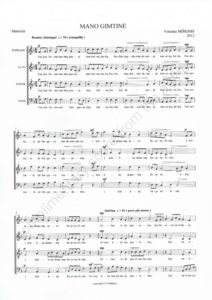


“Mano Gimtiné Pronunciation” from Darius Polikaitis’s Album by Darius Polikaitis. Released: 2013.
AVE VERUM CORPUS
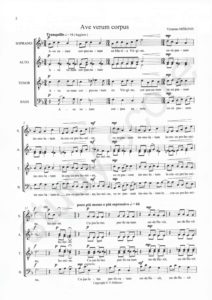

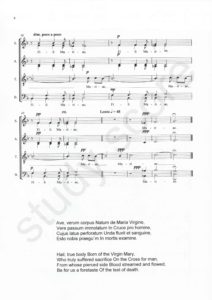
Edited by Gillian Forlivesi Heywood, Italy


